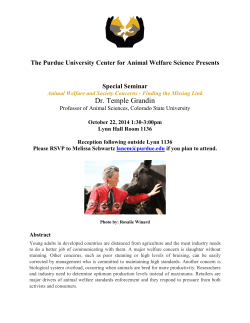
Piezoresistance - RIT - People - Home
Piezoresistance ROCHESTER INSTITUTE OF TECHNOLOGY MICROELECTRONIC ENGINEERING Piezoresistance Dr. Lynn Fuller webpage: http://people.rit.edu/lffeee Electrical and Microelectronic Engineering Rochester Institute of Technology 82 Lomb Memorial Drive Rochester, NY 14623-5604 email: Lynn.Fuller@rit.edu microE program webpage: http://www.microe.rit.edu 5-3-2015 Piezoresistance.ppt © May 5, 2015 Dr. Lynn Fuller Page 1 Piezoresistance INTRODUCTION The piezoresistive effect was first reported in 1954 [1] and has been used in making sensors for years. The effect of strain on the mobility of electrons and holes in semiconductors is important in today's sensors and transistors. © May 5, 2015 Dr. Lynn Fuller Page 2 Piezoresistance CHARLES SMITH 1954 © May 5, 2015 Dr. Lynn Fuller Page 3 Piezoresistance CRYSTAL STRUCTURE Equivalent Planes (100), (010), etc. Directions <110>, <011>, etc. Diamond Lattice (Silicon) Si (100) wafer <110> direction (100) plane z 2 Miller Indices (1/x,1,y,1/z) smallest integer set (111) plane 1 1 2 1 x © May 5, 2015 Dr. Lynn Fuller y 2 Page 4 Piezoresistance PIEZORESISTANCE Piezoresistance is defined as the change in electrical resistance of a solid when subjected to stress, s. The piezorestivity coefficient is and a typical value may be Ecm2/dyne. The fractional change in resistance R/R is given by: R/R = s where sis the stress in dyne/cm2.or N/m2 10 dyne/cm2 = 1Pa = 1 newton/m2 Hooks Law: s= E where E is Young’s modulus © May 5, 2015 Dr. Lynn Fuller Page 5 Piezoresistance SINGLE CRYSTAL DIFFUSED RESISTORS Aluminum contacts z Silicon dioxide y x n-wafer Diffused p-type region The n-type wafer is always biased positive with respect to the p-type diffused region. This ensures that the pn junction that is formed is in reverse bias, and there is no current leaking to the substrate. Current will flow through the diffused resistor from one contact to the other. The I-V characteristic follows Ohm’s Law: I = V/R Sheet Resistance s ~ 1/( qµ Dose) Ro s L/W © May 5, 2015 Dr. Lynn Fuller ohms/square ohms Page 6 Piezoresistance RESISTANCE INCLUDING PIEZOESISTANCE R = Ro [ 1 + pLsxx + pT(syy + szz)] Ro = (L/W)(1/(qµ(N,T) Dose)) pL is longitudinal piezoresistive coefficient pT is transverse piezoresistive coefficient sxx is the x directed stress syy is the y directed stress szz is the z directed stress © May 5, 2015 Dr. Lynn Fuller Page 7 Piezoresistance PIEZORESISTANCE COEFFICIENTS (100) wafer <110> directions In the <110> direction Electrons holes pL (E-11/Pa) pT (E-11/Pa) -31.6 71.8 -17.6 -66.3 Direction of Carrier Flow In the <100> direction Electrons holes pL (E-11/Pa) pT (E-11/Pa) -102 6.6 53.4 -1.1 (100) wafer <100> directions Tensile strain in (100) silicon increases mobility for electrons for flow in <110> direction Compressive strain in (100) silicon increases mobility for holes for flow in <110> direction © May 5, 2015 Dr. Lynn Fuller Page 8 Piezoresistance PIEZORESISTANCE COEFFICIENTS VS DIRECTION (100) wafer <110> directions Kanda Shows piezoresistance coefficients are largest when resistors are oriented perpendicular or parallel to the wafer flat for (100) wafers. © May 5, 2015 Dr. Lynn Fuller Page 9 Piezoresistance PIEZORESISTANCE COEFFICIENTS VS DIRECTION (100) wafer <100> directions Kanda Shows piezoresistance coefficients are largest when resistors are oriented at 45° to the wafer flat for (100) wafers. © May 5, 2015 Dr. Lynn Fuller Page 10 Piezoresistance SUMMARY FOR MOBILITY / STRAIN 1. Mobility is affected by strain in semiconductors. Mobility can be increased or decreased depending on the type of strain (tensile or compressive) and the direction of strain relative to crystal orientation and current flow. For (100) wafers and current flow in <110> direction: 2. Tensile strain n-type silicon enhances mobility of electrons. Tensile strain transverse to current flow enhances mobility of electrons. 3. Compressive strain in the direction of current flow in p-type silicon enhances mobility of holes. Tensile strain transverse to current flow enhances mobility of holes. © May 5, 2015 Dr. Lynn Fuller Page 11 Piezoresistance REFERENCES 1. Charles S. Smith, “Piezoresistance Effect in Germanium and Silicon,” Physical Review, Vol 94, No.1, April 1, 1954. 2. Y. Kanda, “A graphical representation of the piezoresistance coefficients in silicon,” Electron Devices, IEEE Transactions on, vol. 29, no. 1, pp. 64-70, 1982. 3. A. A. Barlian, W. T. Park, J. R. Mallon et al., “Review: Semiconductor Piezoresistance for Microsystems,” Proceedings of the IEEE, vol. 97, no. 3, pp. 513-552, 2009. © May 5, 2015 Dr. Lynn Fuller Page 12
© Copyright 2025









